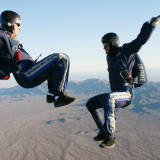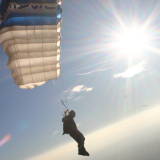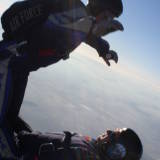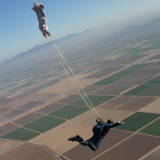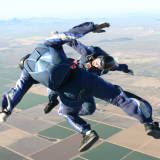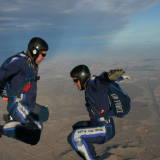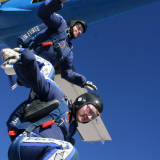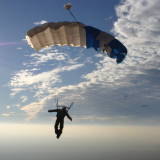
genghis
Members-
Content
8 -
Joined
-
Last visited
Never -
Feedback
0%
Content Type
Profiles
Forums
Calendar
Dropzones
Gear
Articles
Fatalities
Stolen
Indoor
Help
Downloads
Gallery
Blogs
Store
Videos
Classifieds
Everything posted by genghis
-
loosening chest strap/leaning forward
genghis replied to jf951's topic in Swooping and Canopy Control
While gravity will take advantage of that flexible point, so will lift, providing a counter force and thus allowing the system to stay out of the "neutral" position it would be in were it not for lift. What the argument comes down to is whether the center of forces in the entire system of the jumper and parachute is in the three ring (reasonable as the sources of lift are all above them and the forces of weight are all below) or at some point near the parachute (also reasonable based of the arguments presented; since the swing effect of any input on the parachute is focused at a pivot point of the parachute). Depending on which it is, it changes the way the moment arm of the shift in body weight affects the flight of the parachute. -
loosening chest strap/leaning forward
genghis replied to jf951's topic in Swooping and Canopy Control
First let me say that my initial post was intended strictly from a physics standpoint of theoretical benefits of it. I didn't mean to imply that it was the REASON for doing it. "Here's where I'm at - we're hanging from a single point, the three ring, and that point is flexible between the risers and harness. Additionally, the front and rear risers are fixed to each other at that point." To give you an analogous situation: The wing of an aircraft is similarly fixed to the fusalage of the plane. While the angle of the wing will not change relative to the aircraft, the shift of a passenger inside of the aircraft will significantly affect the flight characteristics. "Regardless of where the weight is carried, that single point will flex, and create more or a less a straight line up to the canopy. Imagine if your lines were actually attached to the ceiling of the hanger instead of a canopy." (In theory) a better analogy would be if your lines were attached to a plank balanced and seperately suspended to the ceiling. The angle of that plank will shift depending upon how your weight is in proportion to it. A significant shift in your weight distribution (such as a balanced front riser input) is going to cause the plank to shift forward (similar to how the aircraft noses forward slightly when a 4 way exits. The pilots are used to balancing out for it which is why the seasoned pilots can do it much better than the rookies) and an even shift of weight aft will make it lean back (part of why a pilot generally discourages an ENTIRE plane load to be standing right in the doorway on a big way) Again, my apologies for not giving the disclaimer before that this is just hypothesis of the effect based on aerodynamics and physics. Whether it actually has a significant effect on the flight of a parachute instead of an actual wing may be entirely bullshit, I just meant it as a hypothesis. The REASON I lean forward in my swoops is still just because it feels right, my mentors and coaches taught me to lean forward (either by actually saying it or from watching them) and it has become a part of my comfortable landing sequence. -
To start, I am not a parachute designer, but I am educated in aerodynamics and flight physics. From a fundemental aerodynamics standpoint, the stabilizers on a wing should perform the same function. The airflow is actually in the reverse direction from your post. Air will naturally flow from an area of high pressure to low pressure. The higher speed over the top of a wing will create a low pressure area (the fundemental reason for lift). the phenomena described is a vortex. the High pressure air on the bottom of the wing naturally will "cheat" around the side of the wing by going around the tip of the wing instead of maintaining the pressure and creating lift. this is what creates the vortices off the wingtips of a plane you see flying through fog or a cloud. On a wing like a parachute, when that airflow beats back down on the top of the wing, it breaks up the low pressure, reduces lift, etc. The stabilizer should be breaking that flow of air from bottom to top more so than any little inflatable tube on the top of the end cell. Once again, I am not a parachute designer. I don't know but would be curious how the ram air and fabric skin aspects of a parachute wing might change the practical application in a parachute.
-
loosening chest strap/leaning forward
genghis replied to jf951's topic in Swooping and Canopy Control
In addition to the things already mentioned another beneficial effect of leaning forward in your canopy is a shift of your center of mass/center of gravity. With the connection point still being at your shoulders (most likely slightly behind your shoulders with the chest strap loose) leaning forward will shift your center of gravity aft and up. The aerodynamic effect of the shift in weight is a flaring or planing effect similar to pulling on the both rear risers, but without the distortion to the canopy so the drag caused is less than a proportionate planing due to riser input. Like everyone else said, this mostly applies to the smaller faster canopies that truly fly like wings and follow the principles of aerodynamics. It doesn't really apply to the blimps. -
Believe it or not that thought had occurred to us. Redistribution of the material laterally in the pack job does work to tighten up the bottom flap, however it also makes the pack job significantly wider and then the side flaps are sticking out. It does remove the wrinkles quite well, but the openings get pretty sketchy as the D-bag gets snagged under the corners (if you've jumped a classic, you know that "a sketchy opening on a classic" is a bit of a rhetorical statement) of the reserve tray and the problem is only moderately fixed since then the grommets on the side flaps are the ones exposed. The containers are for the most part the same size, so the 270s fit comfortably in them, the 281s are tight and the 304s are, as pictured, busting out.
-
No worries, no offense taken. As far as the bridle issue is concerned, we have not yet had an issue where a PC in tow was caused by a bridle getting stuck under the bottom flap. Talons and Classic Pro's do not have very stiff bottom flaps on the outer edges, which is probably a blessing in disguise as it allows the bridle to clear by fairly easily. As far as the rigs obviously not fitting the canopies well, all of us who jump them or jumped them in the past (luckily im among the latter) are aware of the problems, but being a Military Jump team, we have to just shut up and color sometimes and just jump the rig we are issued. The Air Force academy and West Point still holds on to Classic Acc quite closely and until that changes, You'll probably always see our 4 ways jumping with turtle shells on their backs. PS. You also might notice that the rig of the tail flyer who's closing loop is so long, is also off centered on his back by about 5 inches, and you can see how much the big rig disturbs a clean body position on all of the flyers.
-
It is an RI container similar to the Talon but it is technically a "Classic Pro" (you can see it on the RI website). The tension on those loops is definitely plenty enough to keep the pin tight, and the majority of the rigs look like that with a little D bag sticking out or at least a significant amount of the bottom flap showing. They are EIFF Classic canopies ranging from 270-304sqft in size. As far as the comment about canopy sizes and flying ability, those canopies are meant to be that big regardless of flying abilities. Most of those guys fly canopies significantly smaller when they aren't jumping for the air force, but that is what they are issued and required to use since they also compete in classic accuracy for the air force. Hope this helps. Blue Skies... Jake
-
Hey, I have a Nitro 135 loaded at about 1.7 (Yeah im a fat ass) and my buddy flies a ST 135 which i have a number of jumps on. From my experiences with them I'd have to agree that it has the best of both worlds. It has the agility, turning, and sportiness just as the Stiletto in the same size. It will hold a dive with very little riser pressure and is amazing on front riser turns like it's zp counterparts. Where it "flies big" is in the landing. It can cruise like you wouldn't believe and hold out a glide till its practically stopped. I jump in CO at over 5000msl and Low winds, no winds, cross winds, I still have yet to run out a landing on it no matter what kind of turn i start her with. The sailcloth maintains amazing rigidity and so the responsiveness is great, but I've had it deep in the corner, avoiding collisions low and all sorts of other hairy conditions and it feels as reliable and safe as a 190. be careful on the size for packing though. My Mirage fit a Xfire 149 fine, but my nitro135 is snug in it. the material is heavy as hell and really thick which makes it a dream to get in the bag, but a bitch to get in the container. Hope this helps. Happy Owner Jake
-
After using a Neptune for 100 jumps or so i decided to sell it because of inaccuracy, difficulty reading the screen, and i got tired of having to replace the batteries so often. I went back to my Galaxy until the viso came out then i figured i would give it a try. I trusted the company already from jumping with 2 of their audibles(pro-track and solo)and knew if they put the same precision and care in a visual altimeter it would be great. When i got it and jumped it, i couldnt have been happier. It was dead on every time, The screen was easy to read, and when i knocked something loose in it the first day of jumping it from a hard bump on exit, L&B was great with customer service and replaced the unit at no cost. I bought the protektor after that and havnt had a problem since then.
-
I bought one and used it for about 30 jumps before deciding to sell it. With small cesna's it isnt very accurate and the altitude would be consistently off by 50-500 feet. Usually it was at least 150 feet off. When i got tired of the unreliablility of the visual altimeter i used it for about a dozen jumps as an alternative audible since my other one doesnt log jumps, but i found it was still very consistently off from my altimaster 3. When jumping from an otter it was very accurate and if that was what most of my jumps were i probably would have kept it, but with a 207 being my primary aircraft I can't count on it.

